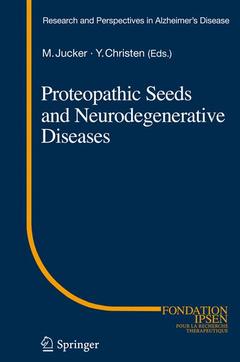Description
Proteopathic Seeds and Neurodegenerative Diseases, 2013
Research and Perspectives in Alzheimer's Disease Series
Coordinators: Jucker Mathias, Christen Yves
Language: English
Subjects for Proteopathic Seeds and Neurodegenerative Diseases:
Keywords
Publication date: 02-2015
156 p. · 15.5x23.5 cm · Paperback
Publication date: 04-2013
156 p. · 15.5x23.5 cm · Hardback
Description
/li>Contents
/li>Comment
/li>
Preface.- Widening Spectrum of Prions Causing Neurodegenerative Diseases (Stanley B. Prusiner).- b-Amyloid Fibril Structures, In Vitro and In Vivo (Robert Tycko).- Structure-Activity Relationship of Amyloids (Jason Greenwald and Roland Riek).- Seeding and Cross-seeding in Amyloid Diseases (Per Westermark and Gunilla T. Westermark).- The Prion-like Aspect of Alzheimer Pathology (Sarah K. Fritschi, Bahareh Eftekharzadeh, Giusi Manfredi, Tsuyoshi Hamaguchi, Götz Heilbronner, Amudha Nagarathinam, Franziska Langer, Yvonne S. Eisele, Lary Walker, Mathias Jucker).- Amyloid-β Transmissibility (Duran-Aniotz C, Morales R, Moreno-Gonzalez I, Soto C).- Prion-like Properties of Assembled Tau Protein (Florence Clavaguera, Markus Tolnay, and Michel Goedert).- Accumulating Evidence Suggests that Parkinson´s Disease is a Prion-like Disorder.- Nolwen L. Rey, Elodie Angot, Christopher Dunning, Jennifer A. Steiner, Patrik Brundin).- Propagation and Replication of Misfolded SOD1: Implications for Amyotrophic Lateral Sclerosis (Anne Bertolotti).- Development of Drugs that Target Proteopathic Seeds Will Require Measurement of Drug Mechanism in Human Brain (Peter T. Lansbury).- The Role of Functional Prions in the Persistence of Memory Storage (Eric R. Kandel, Irina Derkatch, Elias Pavlopoulos).- Subject Index.




